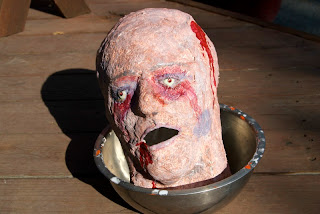You live in a rural neighborhood without much trick-or-treating to speak of and like to take something to the in-town Halloween festivities when you can...so the idea of the zombie piñata begins to take shape. Your child can play out his zombie defense strategy while also having fun with his friends. No animals will be harmed, only an undead creature who means to suck out your brains, anyway.
Your first try in conventional papier mache looks more like an insect than a face and must be abandoned.
Then you remember a package of craft plaster wrap, the kind used for maskmaking and bellycasting...you find a
Your model falls asleep, and his open mouth provides the zombie with the perfect roaring facial expression.
Plaster wrap turns out to be the perfect medium for impulsive last-minute ideas like this, drying as it does in under half an hour instead of the days that papier mache require. In short order, the head is filled out using a balloon and some inflatable packing filler from the garage.
Painting is the fun part. There is a base coat of white, a grey-toned flesh wash, and of course, the requisite purple bruises and red blood.
In the paint box is a squeeze tube of glow-in-the-dark puff paint, and this is added to make eyeballs and lips.
You never thought you would have fun making something this horrible and grotesque. But it's so much fun, it dominates your weekend. You even forget to make food for yourself and your family.
Clothing from the abandoned scarecrow is added, and the head is filled with candy and glow-sticks.
The pièce de résistance: a sound chip connected to a tilt switch, which responds to gravitational position. When the zombie is swung, he will roar:



























